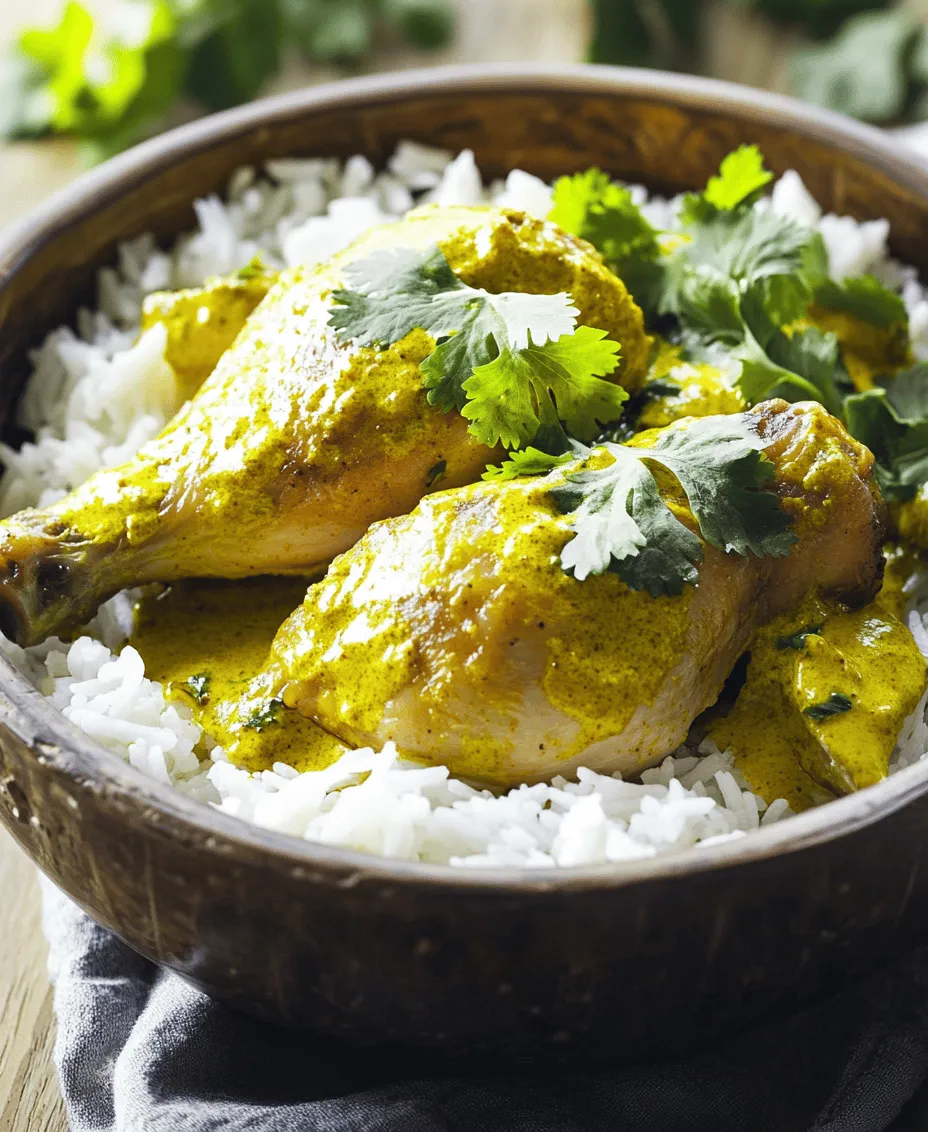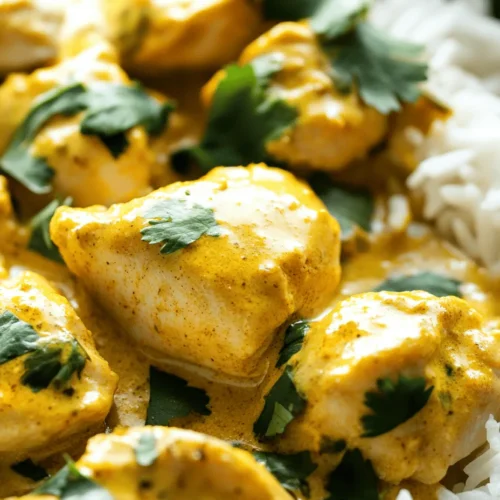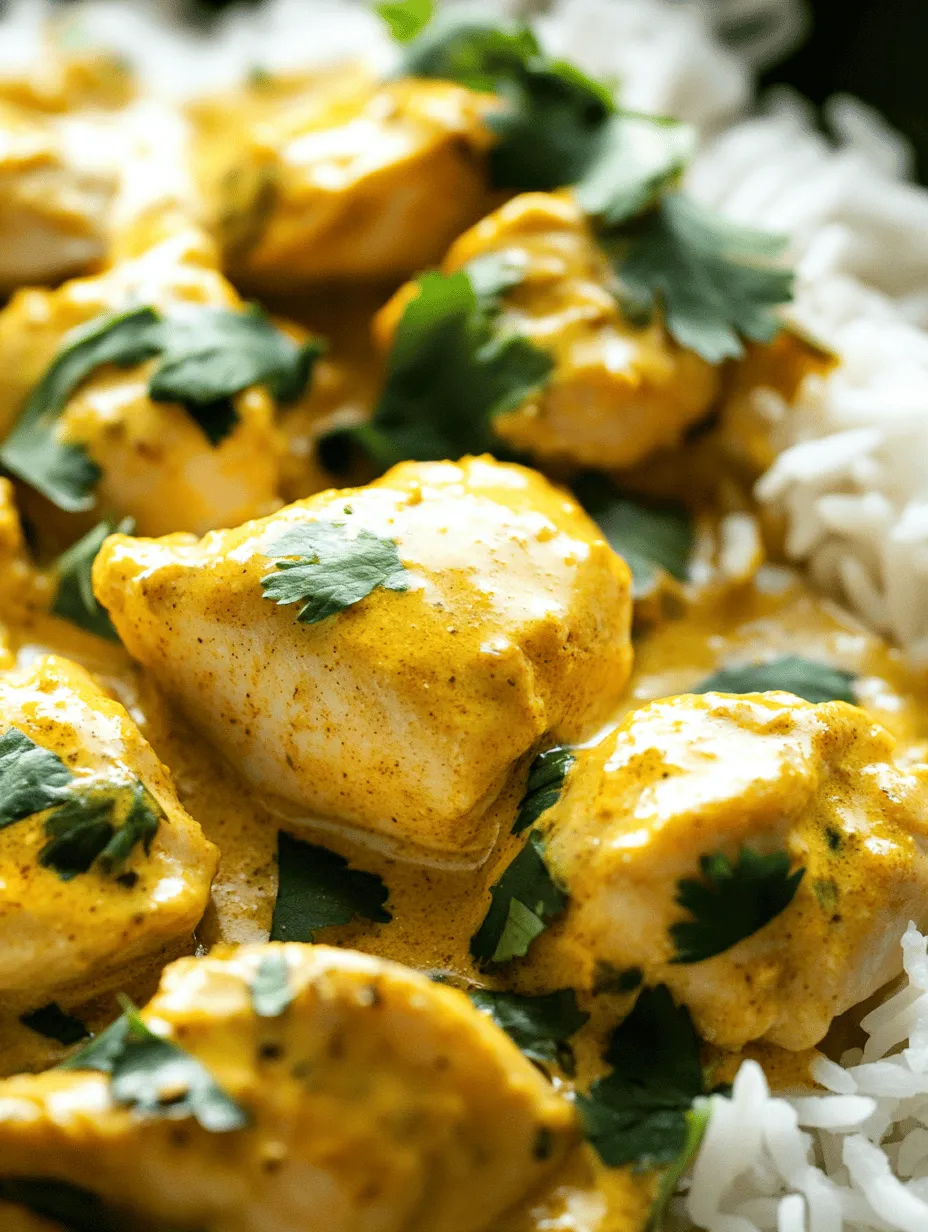Introduction
Kuku Paka, a delectable dish that hails from the shores of East Africa, is a vibrant example of tropical cuisine that embodies the essence of rich flavors and cultural heritage. Originating from coastal communities, particularly in Kenya and Tanzania, Kuku Paka translates to “chicken in coconut” — a name that perfectly encapsulates its primary components. This dish artfully combines tender chicken with the creamy richness of coconut milk, infused with an array of spices that tantalize the taste buds and evoke the warm, inviting atmosphere of the tropics.
The distinctiveness of Kuku Paka lies in its harmonious blend of ingredients. The coconut milk not only serves as the base of the sauce but also contributes a subtle sweetness that balances the savory elements of the dish. The spices—turmeric, coriander, cumin, and garam masala—add complexity and depth, creating a flavor profile that is both bold and comforting. As a result, Kuku Paka has become a favorite in many households, enjoyed not only for its delightful taste but also for its ability to bring people together around the dining table.
In this article, readers can expect a thorough exploration of Kuku Paka, from its cultural significance to the step-by-step process of preparing this tropical delight. Whether you’re a seasoned cook or a culinary novice, this guide will provide you with all the information you need to recreate this popular dish in your own kitchen.
Understanding Kuku Paka
Kuku Paka’s roots are deeply embedded in the culinary traditions of East Africa, where coastal influences from Arab traders and Indian settlers melded to create a unique gastronomic tapestry. The dish is particularly prevalent in coastal regions where seafood and coconut are staples, reflecting the abundance of natural resources available in these areas. Over time, Kuku Paka has evolved from its traditional form to incorporate various ingredients and cooking techniques, showcasing the adaptability and creativity of local cooks.
In many East African communities, Kuku Paka is more than just a meal; it is a symbol of hospitality and communal dining. Traditionally, it is served during special occasions, family gatherings, and celebrations, often accompanied by rice or flatbreads like chapati. The communal aspect of dining is essential, as Kuku Paka is typically enjoyed family-style, allowing everyone to share in the experience. This dish serves as a bridge between different cultures, inviting a diverse audience to savor its rich flavors and engaging presentation.
As Kuku Paka continues to gain popularity beyond its regional origins, it has captured the hearts of food enthusiasts worldwide. Its versatility allows for various adaptations, making it suitable for different dietary preferences while still honoring the essence of the dish. Whether served at a festive gathering or as a comforting weeknight dinner, Kuku Paka remains a beloved representation of tropical cuisine.
Ingredients Overview
The magic of Kuku Paka lies within its carefully selected ingredients, each contributing to the dish’s signature flavor and texture. Here’s a closer look at the key components that make Kuku Paka a standout recipe:
Chicken
The star of Kuku Paka is undoubtedly the chicken. Traditionally, bone-in chicken pieces are preferred as they provide richness and depth during cooking. The skin on the chicken helps lock in moisture and flavor, while the bones add a savory quality to the sauce. For a healthier option, skinless chicken breasts or thighs can be used, though they may require additional seasoning to achieve the same level of flavor. Marinating the chicken not only enhances its taste but also ensures it remains juicy during cooking, making it an essential step in preparing this dish.
Coconut Milk
Coconut milk is the heart of Kuku Paka, contributing a creamy, luscious texture that complements the spices and chicken. Rich in healthy fats, coconut milk not only enhances the dish’s flavor but also adds nutritional benefits, including vitamins C, E, and B vitamins. The natural sweetness of coconut milk balances the savory spices, creating a harmonious blend that is both satisfying and comforting. For the best results, opt for full-fat coconut milk, which provides a richer sauce compared to lighter alternatives.
Spices and Aromatics
The use of spices is what truly elevates Kuku Paka, infusing the dish with warmth and complexity. Key spices include:
– Turmeric: This vibrant spice not only gives Kuku Paka a beautiful golden hue but also offers anti-inflammatory properties and a mild, earthy flavor.
– Coriander: Ground coriander seeds introduce a citrusy, nutty flavor that brightens up the dish, enhancing the overall taste profile.
– Cumin: With its warm, smoky characteristics, cumin adds depth and richness, grounding the dish in its aromatic roots.
– Garam Masala: A staple in many Indian dishes, garam masala brings a fragrant blend of spices that adds a layer of warmth and complexity to Kuku Paka.
In addition to these spices, fresh aromatics like garlic and ginger are often used to create a fragrant base that enhances the overall flavor.
Fresh Ingredients
To finish off Kuku Paka, fresh ingredients play a crucial role in brightening the dish. Fresh cilantro adds a burst of herbal freshness that cuts through the richness of the coconut milk, while a squeeze of lime juice provides a zesty contrast that elevates the overall taste. These fresh elements are essential for balancing the richness of the dish and adding a lively touch to each serving.
Preparing Kuku Paka
Now that we understand the origins and key ingredients of Kuku Paka, let’s dive into the preparation process. Creating this tropical delight involves several steps, each designed to maximize flavor and texture.
Marinating the Chicken
The first step in preparing Kuku Paka is marinating the chicken. This crucial process allows the flavors to penetrate the meat, ensuring that every bite is infused with the aromatic spices. To create the marinade, combine yogurt or a mixture of spices with salt, garlic, and ginger in a bowl. Coat the chicken pieces thoroughly with the marinade and let them rest for at least 30 minutes, though longer marination times—up to several hours or overnight—will yield even more flavorful results. The acidity in the marinade helps tenderize the chicken, making it juicy and succulent.
Sautéing Aromatics
Once the chicken has marinated, the next step is to sauté the aromatics. In a large skillet or pot, heat a generous amount of oil over medium heat. Add finely chopped onions, garlic, and ginger, allowing them to cook until they are soft and fragrant. This process is key to building the flavor base for Kuku Paka, as it releases the essential oils from the aromatics, creating a rich and inviting aroma. Stir in the spices—turmeric, coriander, cumin, and garam masala—allowing them to bloom and release their flavors. The combination of sautéed aromatics and spices sets the stage for the chicken and coconut milk, creating a tantalizing foundation for the dish.
Cooking the Chicken
After the aromatics have been sautéed, it’s time to introduce the marinated chicken to the pan. Increase the heat slightly and add the chicken pieces, ensuring they are evenly spaced to allow for proper browning. Browning the chicken is essential, as it creates a depth of flavor through caramelization, enhancing the overall taste of the dish. Cook the chicken until it is golden and crispy on the outside, which usually takes about 5-7 minutes per side.
Once the chicken is browned, carefully pour in the coconut milk, scraping any flavorful bits from the bottom of the pan to incorporate them into the sauce. Bring the mixture to a gentle simmer, allowing the chicken to cook through and absorb the flavors of the coconut and spices. This slow cooking process is where Kuku Paka truly comes to life, as the sauce thickens and envelops the chicken in a creamy, aromatic embrace.
By following these initial steps, you set the foundation for a flavorful and satisfying Kuku Paka that will surely impress diners at your table. In the next part of this article, we will delve deeper into finishing touches, serving suggestions, and tips for achieving the perfect tropical chicken delight.

Incorporating Coconut Milk
The heart of Kuku Paka lies in its creamy, luscious coconut sauce, which not only enhances the flavor but also contributes to the dish’s tropical essence. To incorporate coconut milk effectively, begin by slowly pouring in the coconut milk after the chicken has been sautéed and coated in the spices. It’s essential that you maintain a moderate heat during this process to allow the coconut milk to blend seamlessly with the ingredients.
Once the coconut milk is added, stir gently to combine all elements and bring the mixture to a simmer. This step is crucial for achieving the optimal texture; a light simmer helps to meld the flavors together without curdling the coconut milk. Allow it to simmer for about 10-15 minutes, uncovered. You’ll notice the sauce thickening and the chicken absorbing the aromatic qualities of the spices and coconut milk. Stir occasionally to prevent sticking, and keep an eye on the consistency; you want a creamy sauce that clings beautifully to the chicken.
Adjusting Seasoning
As the dish simmers, it’s important to taste and adjust the seasoning. The goal is to achieve a perfect balance of flavors. Start by adding salt a little at a time, tasting after each addition. Coconut milk can sometimes mellow the spices, so you may need to increase the heat with a pinch of cayenne or additional ginger if you desire more kick. Freshly cracked black pepper can also enhance the dish’s depth.
If you find that the flavors are too rich, a splash of lime juice can brighten the sauce and add a refreshing acidity that balances the sweetness of the coconut milk. Remember, adjusting the seasoning is a personal journey—make it your own by incorporating your favorite spices or herbs as you see fit.
Serving Suggestions
Kuku Paka is a versatile dish that can be served in various ways, making it suitable for different meal preferences.
With Rice
One of the most popular ways to serve Kuku Paka is with rice. The creamy coconut sauce pairs beautifully with different types of rice, including:
– Basmati Rice: This fragrant rice complements the tropical flavors of Kuku Paka perfectly, providing a light and fluffy base.
– Jasmine Rice: Known for its subtle floral aroma, jasmine rice enhances the overall dining experience and adds an exotic touch.
– Brown Rice: For a healthier option, brown rice offers added nutrients and a nutty flavor that contrasts nicely with the dish’s creaminess.
Simply spoon a generous portion of Kuku Paka over your chosen rice, allowing the sauce to soak in for maximum flavor.
With Ugali
Another traditional pairing for Kuku Paka is ugali, a staple in many East African households. Ugali is made from maize flour and water, cooked into a dense, dough-like consistency. Its neutral flavor acts as the perfect canvas for the rich sauce of Kuku Paka. To serve, mold the ugali into small balls or serve it in slices, and use it to scoop up the chicken and sauce. This combination not only offers a satisfying meal but also ties in cultural practices that celebrate communal eating.
Garnishing Options
Enhance your Kuku Paka with fresh garnishes that add flavor and visual appeal. Consider these options:
– Fresh Cilantro or Parsley: Chopped herbs add a pop of color and a burst of freshness that complements the rich sauce.
– Sliced Lime Wedges: Provide a zesty squeeze of lime over the dish before serving; the acidity brightens up the flavors.
– Chili Flakes or Sliced Chilies: For those who enjoy heat, a sprinkle of chili flakes or fresh slices will elevate the dish’s spice level.
Nutritional Information
Kuku Paka is not just a delicious meal; it also offers several nutritional benefits. Here’s a breakdown of its components:
– Coconut Milk: Rich in healthy fats, particularly medium-chain triglycerides (MCTs), coconut milk can provide quick energy. It also contains lauric acid, which has antimicrobial properties. Additionally, coconut milk is a good source of vitamins C and E, supporting overall health.
– Chicken: A great source of lean protein, chicken is essential for muscle repair and growth. It also provides B vitamins, which are important for energy metabolism.
– Spices: Ingredients like ginger, garlic, and turmeric not only enhance flavor but also offer anti-inflammatory and antioxidant benefits.
When enjoyed in moderation, Kuku Paka can fit well into a balanced diet. Its combination of protein, healthy fats, and spices makes it a hearty meal option perfect for replenishing energy after a long day.
Variations of Kuku Paka
One of the beautiful aspects of Kuku Paka is its adaptability. Here are some variations to consider:
Vegetarian Option
For those following a vegetarian or plant-based diet, Kuku Paka can be reimagined using alternatives such as tofu or chickpeas. Tofu absorbs the flavors of the spices and coconut milk beautifully, creating a hearty dish. Simply substitute the chicken with cubed firm tofu, sautéing it until golden brown before adding the coconut milk. Chickpeas can also work well, offering a nutty flavor and additional protein.
Spice Levels
Adjusting the spice levels in Kuku Paka is easy and can cater to everyone’s palate. If you prefer a milder dish, reduce the amount of black pepper and cayenne. Conversely, for those who enjoy a spicy kick, consider adding fresh chilies or increasing the cayenne pepper.
Regional Variations
Kuku Paka varies across regions, and each place has its twist on the traditional recipe. In some coastal areas, you might find variations that incorporate seafood instead of chicken, such as shrimp or fish, creating a delightful seafood curry. Other regions may add different vegetables or legumes to the mix, showcasing local produce and flavors.
Conclusion
Kuku Paka is more than just a meal; it’s a celebration of flavors and cultural significance. The rich blend of coconut milk, spices, and tender chicken creates a comforting dish that is perfect for sharing with family and friends. Its versatility allows for various serving options, whether with rice, ugali, or innovative garnishes, making it suitable for any occasion.
As you embark on your culinary journey to create Kuku Paka, remember that cooking is not just about the end result but also about the joy of the process and the memories made along the way. We encourage you to try making this delightful dish at home, allowing the enticing aromas and flavors to fill your kitchen. Whether you stick to the traditional recipe or experiment with variations, Kuku Paka is sure to become a beloved addition to your culinary repertoire, offering comfort and satisfaction with every bite.



